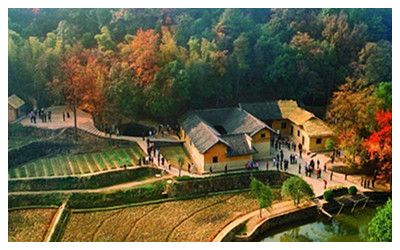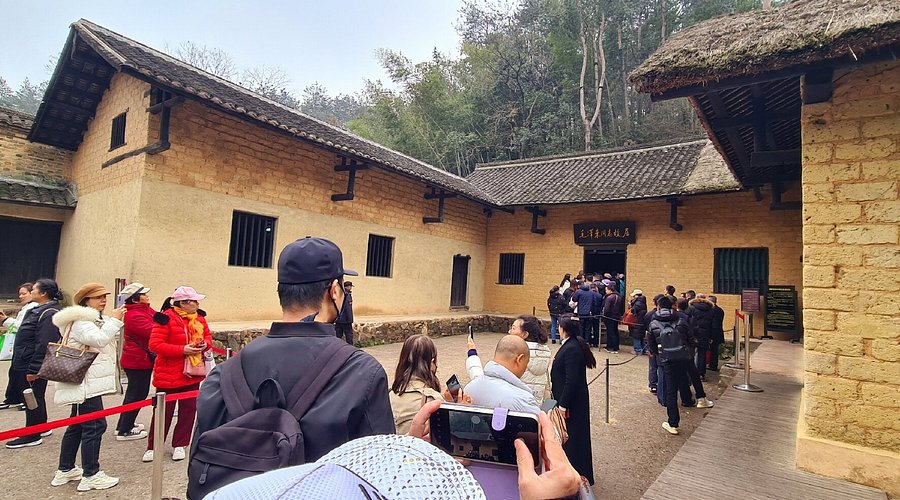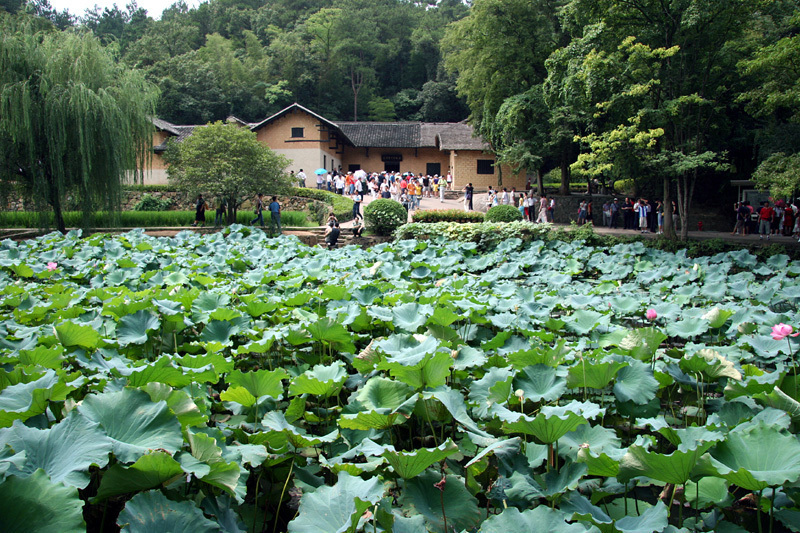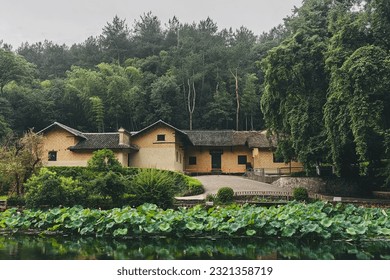What Can You Learn from Visiting Mao Zedong’s Childhood Home in Shaoshan?
An Essential Guide to Visiting Shaoshan Mao Zedong’S Former Residence
Nestled in the picturesque countryside of Hunan Province, Shaoshan Mao Zedong’s Former Residence offers visitors a rare glimpse into the formative years of one of the 20th century’s most influential figures. This humble abode, where Mao lived until the age of 16, is not just a relic of history; it is a testament to the humble beginnings of a man who would go on to shape the destiny of a nation. The residence itself, constructed primarily of timber and mud, stands as a poignant reminder of the agrarian lifestyle of Mao’s childhood, surrounded by lush landscapes that add to its charm.
In this essential guide, we will navigate through the key features of Mao Zedong’s Former Residence, highlighting its significance in the broader context of Chinese history. From practical tips for your visit, including opening hours and nearby attractions, to insights into the exhibits that detail Mao’s early life, this guide aims to enrich your experience as you walk through the past. Whether you’re a history enthusiast or simply curious about China’s revolutionary heritage, Shaoshan offers an unforgettable journey into the roots of Mao Zedong’s legacy. Prepare to be inspired by the stories that linger within these walls and the vibrant culture of the region that continues to thrive today.
In This Guide
- An Essential Guide to Visiting Shaoshan Mao Zedong’S Former Residence
- The Rich History and Legends of Shaoshan Mao Zedong’S Former Residence
- Main Highlights: What You Absolutely Can’t Miss
- Planning Your Visit: A Practical Guide
- Tickets: Prices, Booking, and Tips
- How to Get There: A Complete Transportation Guide
- Local Cuisine and Accommodation Nearby
- Frequently Asked Questions
- Final Thoughts on Your Trip
The Rich History and Legends of Shaoshan Mao Zedong’S Former Residence
The Story Behind Shaoshan: Mao Zedong’s Childhood Residence
Nestled in the serene landscapes of Hunan Province, the former residence of Mao Zedong in Shaoshan is not just a house; it is a tangible link to the early life of one of the 20th century’s most influential figures. This modest abode, made primarily of mud and timber, served as the backdrop for Mao’s formative years, shaping his thoughts and ideals that would later spark a revolution.
A Humble Beginning
Mao Zedong was born on December 26, 1893, in Shaoshan, into a family of middle peasants. His father, a landowner and money lender, instilled in him a sense of ambition and a love for learning. The residence itself, where Mao lived until the age of 16, offers visitors a glimpse into the simple rural life that characterized his childhood. The house is filled with artifacts and furniture that evoke the era, providing a rare insight into the daily life of young Mao and his family.
Key Historical Events
The significance of Mao’s former residence goes beyond its physical structure. It marks the starting point of a journey that would lead him from the fields of Hunan to the political stage of China. As a child, Mao often clashed with his father over expectations and responsibilities, a dynamic that would later inform his views on authority and governance. The tensions in his family life, coupled with the socio-political upheavals of the time, cultivated a critical mindset that would later be pivotal in his revolutionary activities.
In 1911, as the Qing dynasty fell and the Republic of China was established, a young Mao began to explore new ideas about governance and society. His experience in Shaoshan, combined with his education, laid the foundation for his future political ideologies.
Legends and Local Lore
Among the many legends associated with Shaoshan is the tale of Mao’s fierce determination as a student. It is said that he would often sneak away from his chores to read books in secret, motivated by a desire to escape the limitations of his rural upbringing. This legend not only highlights Mao’s early dedication to education but also serves as a metaphor for his later ambitions to uplift the masses through education and reform.
Another intriguing story involves the natural beauty surrounding Shaoshan. Locals believe that the lush hills and flowing streams not only inspired Mao’s revolutionary spirit but also offered him solace during his turbulent youth. Many visitors remark on the serene atmosphere of the area, which seems to echo the youthful dreams of a boy who would one day change the course of history.
A Site of Reflection
Today, Mao Zedong’s former residence stands as a museum, attracting thousands of visitors each year who are keen to understand the roots of his ideology. While the house itself may seem small, it is a powerful reminder of how humble beginnings can lead to monumental changes in society. The long queues of visitors—predominantly domestic tourists—reflect the ongoing interest in Mao’s life and legacy, highlighting the residence as a crucial stop for anyone wishing to delve into China’s rich historical tapestry.
As you walk through the rooms where Mao spent his formative years, you can almost hear the echoes of his childhood laughter and youthful debates. Shaoshan is not just a destination; it is a pilgrimage into the heart of modern Chinese history, inviting travelers to reflect on the complexities of a man who remains both revered and controversial.
Conclusion
The history and legends surrounding Shaoshan’s Mao Zedong Former Residence provide a captivating insight into the early influences that shaped one of the world’s most notorious leaders. As you explore this historic site, consider the rich narratives woven into its walls, reflecting the aspirations and struggles of a young boy destined to leave an indelible mark on the world.

Shaoshan Mao Zedong’S Former Residence.
Main Highlights: What You Absolutely Can’t Miss
The Former Residence of Mao Zedong
Step into history at Mao Zedong’s Former Residence, where the iconic Chinese leader spent his formative years. This quaint abode offers a glimpse into the childhood of a man who would go on to shape the course of a nation. As you navigate through the residence and its surroundings, you’ll uncover the essence of Mao’s early life and the influences that molded him. Here are the highlights you absolutely cannot miss.
1. Mao Zedong’s Childhood Home
This humble home, where Mao lived until he was 16, is the centerpiece of your visit. Constructed primarily from mud and timber, it reflects the traditional architecture of rural Hunan. Inside, you’ll find a modest array of furnishings that speak to the simplicity of peasant life. Tip: Expect long queues during peak tourist seasons, especially with domestic visitors. Early morning visits can help you avoid the rush.
2. The Bronze Statue of Mao Zedong
Just a short walk from the residence, you’ll encounter the impressive bronze statue of Mao Zedong, standing tall in the square. This striking monument captures the essence of Mao’s legacy and is a favorite spot for photos among visitors. Tip: Visit during the late afternoon when the sunlight beautifully illuminates the statue, providing an excellent backdrop for your photos.
3. Mao Zedong Memorial Museum
Adjacent to the former residence is the Mao Zedong Memorial Museum, which houses a wealth of artifacts and exhibits related to Mao’s life and the history of the Communist Party in China. The museum provides a deeper understanding of Mao’s impact on modern China. Tip: Allocate at least an hour to explore the museum thoroughly, and don’t miss the guided tours available for richer context.
4. Mao’s Ancestral House
This nearby site offers additional insight into Mao’s family background. Located within walking distance, the ancestral house showcases the lifestyle of Mao’s ancestors and the agricultural practices of the time. Tip: Combine your visit here with a walk through the surrounding countryside to appreciate the rural charm of Shaoshan.
5. The Poetry Forest of Steles
Located a bit further from the main attractions, this serene site features steles inscribed with Mao’s poetry. It’s a peaceful spot to reflect on Mao’s literary contributions and enjoy the natural beauty of the area. Tip: Bring a book or journal to jot down your thoughts as you soak in the tranquil atmosphere.
6. Mingyuan Park
Complete your visit with a stroll through Mingyuan Park, which is situated near the residence. The park is a beautiful area with traditional landscaping and tranquil ponds, perfect for unwinding after your explorations. Tip: Look for quiet benches where you can relax and enjoy a snack from one of the local vendors.
7. Local Cuisine Sampling
While in Shaoshan, don’t miss out on tasting the local Hunan cuisine. Look for small eateries serving spicy dishes that are characteristic of the region. Tip: Try the famous Hunan hot pot or the local specialty, stinky tofu, for an authentic culinary experience.
Visiting Mao Zedong’s Former Residence is not just a historical journey; it’s an opportunity to understand the roots of a complex figure in world history. Each of these highlights will enrich your understanding of both Mao’s life and the cultural heritage of Shaoshan, making for an unforgettable experience.

Shaoshan Mao Zedong’S Former Residence.
Planning Your Visit: A Practical Guide
Discovering Mao Zedong’s Former Residence in Shaoshan
Visiting the birthplace of one of the most significant figures in modern history, Mao Zedong, offers a unique glimpse into China’s revolutionary past. Here’s how to make the most of your visit to Shaoshan Mao Zedong’s Former Residence.
Best Time to Visit
The ideal times to visit Shaoshan are during the spring (April to June) and autumn (September to November) months. The weather during these seasons is generally mild and pleasant, making it comfortable for exploration. Avoid visiting during the summer months, as temperatures can soar, leading to a less enjoyable experience. Additionally, try to avoid national holidays, such as the Golden Week in early October, when crowds can swell dramatically.
Recommended Itinerary
- Morning: Arrival and Exploration
- Start your day early to avoid the crowds. Arrive at the Mao Zedong Former Residence around 8:30 AM when it opens.
-
Spend time exploring the house where Mao lived until he was 16. Take note of the traditional architecture and artifacts that reflect his upbringing.
-
Midday: Lunch and Further Exploration
- After touring the residence, head to a nearby restaurant for a taste of local Hunan cuisine. Look for dishes like spicy fish or stinky tofu for an authentic experience.
-
Post-lunch, visit the Mao Zedong Memorial Museum to deepen your understanding of his life and legacy.
-
Afternoon: Cultural Immersion
- Stroll through Mao Zedong Bronze Statue Square to capture iconic photographs and soak in the atmosphere.
-
If time allows, explore nearby attractions like the Shaoshan Dishui Cavern or Mao’s Ancestral House.
-
Evening: Reflection and Departure
- Wind down your day with a visit to local shops for souvenirs before heading back.
Photography Tips
- Golden Hour: The best light for photography is during the early morning or late afternoon. Capture the residence in soft, warm light for stunning results.
- Historical Context: Focus on details such as the architecture, artifacts, and local life to convey the essence of this historical site.
- Crowd Management: Arrive early to avoid crowds, allowing for unobstructed shots of key areas around the residence and the surrounding landscapes.
- Respectful Captures: Be mindful of other visitors and the solemnity of the site, especially when photographing exhibits or memorials.
What to Wear
- Comfortable Footwear: Expect to walk quite a bit. Sturdy shoes are essential for navigating the uneven terrain around the residence and other nearby attractions.
- Weather-Appropriate Clothing: Dress in layers, particularly in spring and autumn, as temperatures can vary significantly throughout the day.
- Sun Protection: If visiting in warmer months, bring a hat and sunscreen as much of the area is exposed to sunlight.
Insider Tips
-
Prepare for Queues: Expect long lines, especially during weekends and holidays. Plan your visit during weekdays if possible to avoid peak crowds.
-
Lockers Available: Large bags and cameras may need to be stored in lockers at the entrance. Travel light to streamline your entry.
-
Engage with Guides: Consider hiring a local guide for a richer experience. They can provide valuable insights and stories about Mao’s life that you won’t find in brochures.
-
Plan for Snacks: Pack light snacks and water, as dining options can be limited in the immediate vicinity of the residence.
-
Respect Local Customs: Be aware of the cultural significance of the site, maintaining a respectful demeanor, especially in quieter areas or during memorial observances.
With this practical guide, your visit to Shaoshan Mao Zedong’s Former Residence will be both enlightening and enjoyable, offering a deeper understanding of one of China’s most influential figures. Enjoy your journey into history!

Shaoshan Mao Zedong’S Former Residence.
Tickets: Prices, Booking, and Tips
When planning your visit to Mao Zedong’s Former Residence in Shaoshan, it’s essential to know the ticketing details to ensure a smooth experience. Below is a breakdown of ticket types, pricing, and what each ticket includes:
| Ticket Type | Price (CNY) | Includes |
|---|---|---|
| Adult Admission | 30 | Access to Mao Zedong’s Former Residence |
| Student Admission | 15 | Access to Mao Zedong’s Former Residence (valid student ID required) |
| Group Ticket (10+) | 25 per person | Access to Mao Zedong’s Former Residence (advance booking necessary) |
Booking Information
Booking your tickets in advance is highly recommended, especially during peak tourist seasons and weekends, when the site tends to attract large crowds. Here are some tips on how to secure your tickets:
-
Online Booking: Tickets can often be booked through local travel agencies or platforms that specialize in Chinese attractions. Websites like Ctrip or your hotel concierge can assist with reservations.
-
On-Site Purchase: If you prefer to buy tickets on the day of your visit, arrive early to avoid long lines. Be prepared for potential waits, especially during busy periods.
-
Group Tours: Consider joining a guided tour that includes tickets to the residence, as this can streamline your visit and provide additional insights into the historical significance of the site.
-
Plan Your Visit: The residence is open daily from 8:30 AM to 4:00 PM, so plan your visit accordingly. Arriving early in the day can enhance your experience, allowing you to explore without the major crowds.
Make sure to check for any special events or closures that may affect your visit, and remember to bring your identification, especially if you’re purchasing a student ticket. With a little planning, your trip to Mao Zedong’s Former Residence will be both enlightening and enjoyable!
How to Get There: A Complete Transportation Guide
Reaching the Historic Heart of Shaoshan
Visiting Mao Zedong’s Former Residence in Shaoshan offers a fascinating glimpse into the childhood of one of China’s most pivotal figures. However, getting there requires some planning. Here’s a comprehensive transportation guide to help you navigate your journey to this historical site.
From the Nearest Major City: Changsha
By Train
Changsha, the capital of Hunan Province, is the nearest major city to Shaoshan and is well-connected by high-speed trains. The journey to Shaoshan takes approximately 1.5 hours.
- Train Options: Frequent trains run from Changsha South Railway Station to Shaoshan Railway Station.
- Cost: Tickets typically range from CNY 30 to CNY 50 (approximately USD 5 to USD 8), depending on the class.
- Booking: Tickets can be purchased at the station or booked online through various travel platforms.
By Bus
For a more economical option, you can take a bus from Changsha to Shaoshan.
- Departure Point: Buses leave from the Changsha West Bus Station.
- Duration: The bus ride takes about 2 to 2.5 hours.
- Cost: Expect to pay around CNY 20 to CNY 30 (about USD 3 to USD 5).
- Frequency: Buses run regularly throughout the day.
By Car
If you prefer the flexibility of driving, renting a car is also an option.
- Route: The drive from Changsha to Shaoshan is approximately 90 kilometers (about 56 miles).
- Duration: It takes around 1.5 to 2 hours depending on traffic.
- Rental Cost: Car rental prices vary, but expect to pay around CNY 300 to CNY 600 (approximately USD 50 to USD 100) per day, plus fuel.
Getting Around the Scenic Area
Once you arrive in Shaoshan, navigating the area is quite straightforward, as many attractions are within walking distance.
Walking
– The main sites, including Mao Zedong’s Former Residence, the Mao Zedong Memorial Museum, and the bronze statue, are all located close to each other. A leisurely walk can enhance your experience of the local scenery and culture.
Local Buses and Taxis
– If you prefer not to walk, local buses and taxis are available to help you reach your desired attractions.
– Buses: A local bus service operates within Shaoshan, typically costing around CNY 2 (about USD 0.30) per ride.
– Taxis: Taxis are also available, with fares starting at CNY 10 (about USD 1.50) for the first kilometer and increasing thereafter.
Tour Packages
– Various tour operators offer guided tours from Changsha, which often include transportation, a guide, and entry fees to attractions. Prices for these packages can range from CNY 300 to CNY 500 (approximately USD 50 to USD 80), depending on the inclusions.
Tips for Your Journey
- Timing: Aim to visit during weekdays to avoid large crowds, as weekends can be particularly busy with domestic tourists.
- Entry Requirements: Be prepared for security checks at the residence, and note that large bags may need to be stored in lockers.
- Language: While some signage is in English, having a translation app can be helpful for navigating public transport and communicating with locals.
By following this guide, you’ll be well on your way to experiencing the rich history of Mao Zedong’s childhood residence in Shaoshan. Enjoy your journey!

Shaoshan Mao Zedong’S Former Residence.
Local Cuisine and Accommodation Nearby
Visiting Shaoshan Mao Zedong’s Former Residence offers a unique glimpse into China’s revolutionary history, and it’s equally important to dive into the local flavors and find a comfortable place to rest after exploring. Here’s a delightful guide to local cuisine and accommodation options nearby.
Local Delicacies to Savor
-
Hunan Spicy Fish (剁椒鱼头)
This signature dish features fish head, often from a freshwater source, simmered with a generous amount of chopped pickled chilies. The dish is known for its fiery flavor and is a must-try for spice enthusiasts. -
Steamed Pork with Preserved Vegetables (梅菜扣肉)
A classic Hunan dish, this is a savory and succulent pork belly layered with preserved mustard greens. The combination offers a rich, slightly sweet flavor that perfectly balances the dish’s saltiness. -
Stir-Fried Fresh Bamboo Shoots (鲜竹笋炒肉)
A seasonal delight, fresh bamboo shoots stir-fried with pork or chicken capture the essence of Hunan’s natural produce. The crunchiness of the shoots combined with tender meat makes for a refreshing dish. -
Hunan Rice Noodles (米粉)
Popular throughout the region, these rice noodles are often served in a spicy broth, topped with a variety of ingredients such as vegetables, meat, and herbs. It’s a comforting dish perfect for any time of day.
Comfortable Stays Nearby
-
Luxury: Shaoshan International Hotel (韶山国际酒店)
Offering modern amenities and stunning views, this hotel features elegantly designed rooms, a full-service spa, and gourmet dining options. It’s perfect for travelers looking for comfort and class while being close to historical sites. -
Boutique: The Shaoshan Museum Hotel (韶山博物馆酒店)
This charming hotel exhibits a unique blend of traditional Hunan architecture and contemporary design. With personalized service and a cozy atmosphere, it’s ideal for travelers seeking a more intimate experience. -
Budget: Shaoshan Youth Hostel (韶山青年旅舍)
For those traveling on a budget, this hostel provides clean, shared accommodations with a friendly vibe. It’s a great place to meet fellow travelers and is conveniently located near the main attractions.
Taking the time to indulge in Shaoshan’s culinary offerings and selecting the right place to stay will enhance your visit to Mao Zedong’s Former Residence, making your trip both memorable and delicious.

Shaoshan Mao Zedong’S Former Residence.
Frequently Asked Questions
-
Is Mao Zedong’s Former Residence suitable for children and the elderly?
Yes, Mao Zedong’s Former Residence is accessible for families with children and elderly visitors. The site is relatively flat, and while there may be some stairs, the overall layout is manageable. However, it’s advisable to keep an eye on younger children, as the area can get crowded. -
How much time should I allocate for my visit?
Plan to spend about 1 to 2 hours at the residence itself. This includes time for exploring the house, taking photographs, and enjoying the surrounding gardens. If you wish to visit nearby attractions, like the Mao Zedong Memorial Museum or the bronze statue, consider budgeting an additional hour or two. -
Are there English signs and information available at the site?
Yes, there are English signs and information available at Mao Zedong’s Former Residence. While most of the information is in Chinese, many exhibits and descriptions have been translated into English to assist international visitors. -
What are the operating hours for the residence?
The residence is open daily from 8:30 AM to 4:00 PM. It’s recommended to arrive early, especially on weekends or holidays, as the site can become quite busy, leading to longer wait times. -
Is there an entrance fee for visiting the residence?
Admission to Mao Zedong’s Former Residence is free; however, there may be fees for guided tours or access to certain exhibits nearby. It’s a good idea to check for any changes in pricing before your visit. -
Are there facilities such as restrooms and lockers?
Yes, the site is equipped with public restrooms. Lockers are also available for visitors to store bags or large items while they explore the residence. It’s advisable to leave large bags or cameras in the lockers, especially during peak times. -
What is the best time of year to visit Shaoshan?
The best time to visit Shaoshan is during the spring (March to May) and autumn (September to November) months when the weather is mild and pleasant. Summer can be hot and humid, while winter can bring chilly temperatures. -
Can I take photographs inside the residence?
Photography is generally allowed outside the residence, but inside, it may be restricted in certain areas to preserve the historic integrity of the site. Be sure to check for signs indicating photography restrictions and respect any guidelines provided by staff.
Final Thoughts on Your Trip
Visiting Mao Zedong’s Former Residence in Shaoshan is more than just a journey to a historical site; it’s an immersion into the formative years of one of the 20th century’s most influential figures. As you walk through the humble abode where Mao spent his childhood, you gain unique insights into his early life and the environment that shaped his revolutionary spirit. The residence, adorned with simple, traditional architecture of mud and timber, stands as a testament to his roots, inviting reflection on the complexities of history.
While the lines to enter may be long, they are a small price to pay for the opportunity to connect with a significant chapter of Chinese heritage. Shaoshan is not only a pilgrimage for those interested in Mao’s legacy but also a beautiful area where you can appreciate the tranquil landscape that once cradled his dreams.
As you conclude your visit, take a moment to consider the broader narrative of transformation and the resilience of ordinary people throughout history. Your trip to Shaoshan serves as a reminder that every great leader begins as a child with dreams of a better world. Embrace the stories and lessons from this site, and let them inspire your own journey, wherever it may lead you next.